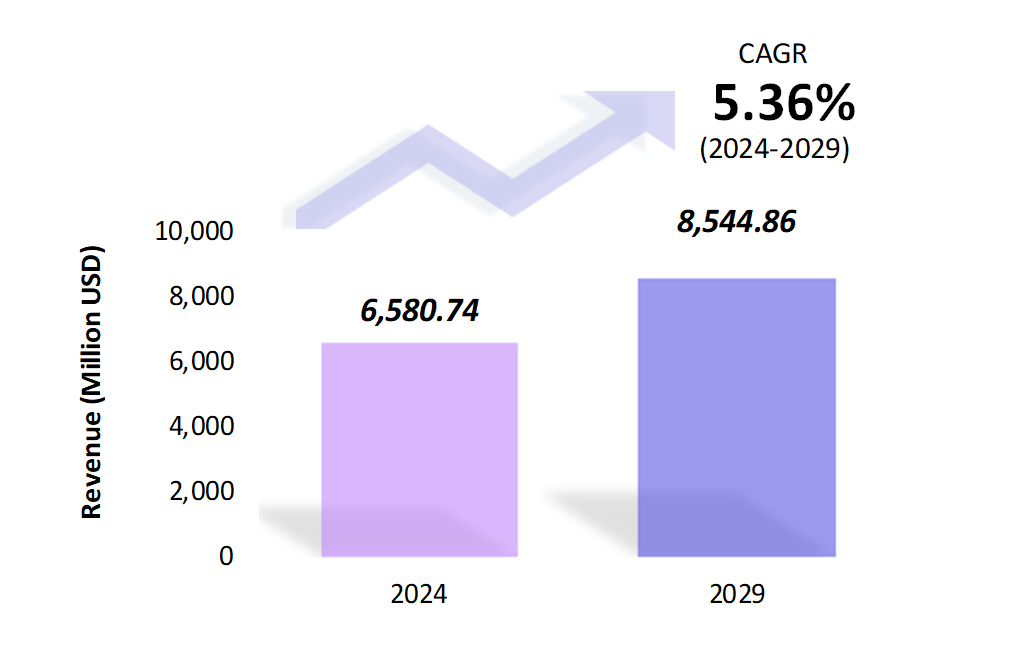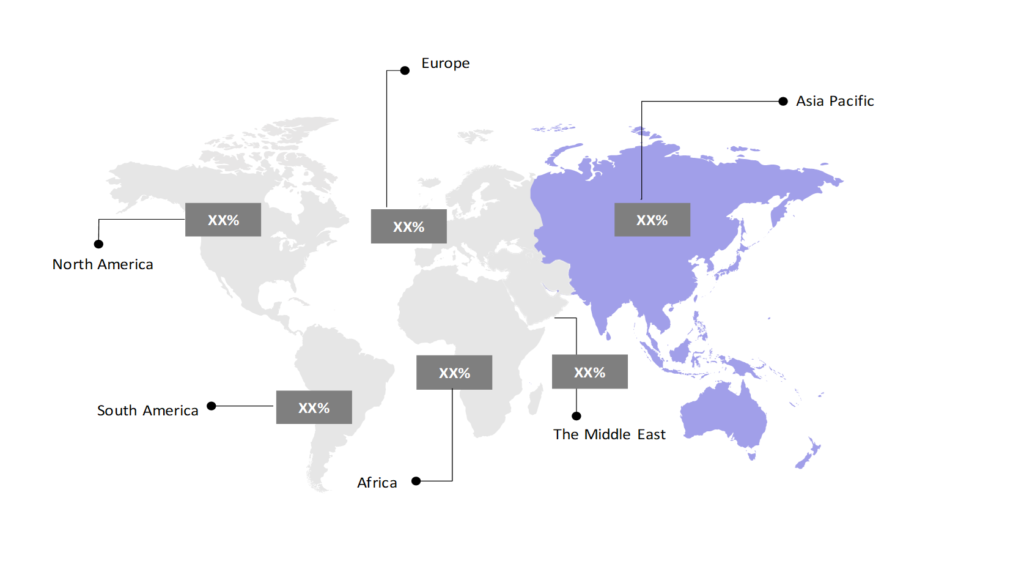Airport Automation Market Analysis: Growth, Size, Share & Future Trends (2024-2029)
The market report presents a thorough analysis segmented by System (Data Acquisition and Communication, Automation and Control, Data Storage, Software & Solutions); by Application (Baggage Handling and Tracking, Ground Transportation and Parking, Retail and Dining, Facility Management, Others); by Airport Side (Land Side, Air Side, Others); by Geography (North America, South America, Asia Pacific, Europe, The Middle East, Africa).
Outlook

- The airport automation market is estimated to be at USD 6,580.74 Mn in 2024 and is anticipated to reach USD 8,544.86 Mn in 2029.
- The airport automation market is registering a CAGR of 5.36% during the forecast period of 2024-2029.
- The airport automation market is rapidly expanding, driven by technological advancements and increasing passenger demand for efficiency. Innovations such as self-service kiosks, automated baggage handling, and biometric security are transforming airport operations, enhancing passenger experience, and improving overall efficiency.
Request a free sample.
Ecosystem

- The global airport automation industry participants are always developing strategies to preserve a competitive advantage.
- These companies focus on technology innovation, strategic partnerships, and acquisitions to expand their market presence and capabilities.
- Several important entities in the airport automation market include Siemens Ltd.; Honeywell International Inc.; Daifuku Co., Ltd.; Amadeus IT Group, S.A.; Leonardo SpA; and others.
Ask for customization.
Findings
| Attributes | Values |
|---|---|
| Historical Period | 2018-2022 |
| Base Year | 2023 |
| Forecast Period | 2024-2029 |
| Market Size (2024) | USD 6,580.74 Mn |
| Market Size (2029) | USD 8,544.86 Mn |
| Growth Rate | 5.36% CAGR from 2024 to 2029 |
| Key Segments | System (Data Acquisition and Communication, Automation and Control, Data Storage, Software & Solutions); Application (Baggage Handling and Tracking, Ground Transportation and Parking, Retail and Dining, Facility Management, Others); Airport Side (Land Side, Air Side, Others); Geography (North America, South America, Asia Pacific, Europe, The Middle East, Africa) |
| Key Vendors | Siemens Ltd.; Honeywell International Inc.; Daifuku Co., Ltd.; Amadeus IT Group, S.A.; Leonardo SpA. |
| Key Countries | The US; Canada; Mexico; Brazil; Argentina; Colombia; Chile; China; India; Japan; South Korea; The UK; Germany; Italy; France; Spain; Turkey; UAE; Saudi Arabia; Egypt; South Africa |
| Largest Market | Asia Pacific |
Get a free quote.
Trends
- Biometric Integration: Using biometric technologies for passenger identification and security is expanding. For example, in June 2024, Hong Kong International Airport launched a comprehensive biometric system that integrates facial recognition for check-in, security, and boarding, enhancing security and efficiency.
- Smart Baggage Handling: Innovations in baggage handling, such as RFID tagging and automated sorting systems, are increasingly popular as they enhance efficiency, reduce lost luggage incidents, and streamline airport operations. These technologies provide real-time tracking and automated routing, significantly improving the passenger experience and operational performance.
- Automated Energy Management System: Airports are adopting automation to support sustainability goals. For example, in February 2024, Munich Airport implemented an automated energy management system to optimize energy use and reduce carbon emissions, aligning with global sustainability trends.
Speak to analyst.
Catalysts
- Rising Air Traffic: Rising passenger numbers are pushing airports to adopt advanced technologies and streamlined processes to handle the growing volume efficiently. This demand for improved operational efficiency includes implementing automated systems, optimizing security checks, and expanding infrastructure to ensure a smoother and faster travel experience.
- Rise in Robotic Automation: Automation enhances operational efficiency by streamlining processes and reducing human error. For example, in January 2024, Singapore’s Changi Airport upgraded its baggage handling system with advanced robotics, resulting in a 20% increase in baggage processing efficiency.
- Growth of Self-Check-in Kiosks: Automated systems enhance the passenger experience by cutting down on wait times through self-check-in kiosks, automated baggage drop-offs, and biometric screening. These advancements streamline the travel process, reduce queues, and offer a more efficient, user-friendly journey from check-in to boarding.
Inquire before buying.
Restraints
- High Initial Investment: Adopting advanced automation technologies requires a significant initial investment in equipment and infrastructure, presenting a significant challenge for airports. While these technologies offer long-term savings and efficiency improvements, the substantial upfront costs can strain budgets.
- Cybersecurity Risks: The increasing reliance on digital systems makes airports vulnerable to cyberattacks. For example, in March 2024, a cybersecurity breach at Atlanta’s Hartsfield-Jackson Airport disrupted operations for several hours, underscoring the need for robust cybersecurity measures.
- Divergent Regulatory Compliance: Adhering to diverse regulatory standards across regions poses a significant challenge for implementing automation technologies. Airports must navigate a complex landscape of local, national, and international regulations, complicating technology deployment and increasing compliance costs. This can potentially delay projects and affect overall efficiency.
Personalize this research.
Hotspot

Explore purchase options.
Table of Contents
| 1. Introduction 1.1. Research Methodology 1.2. Scope of the Study 2. Market Overview / Executive Summary 2.1. Global Airport Automation Market (2018 – 2022) 2.2. Global Airport Automation Market (2023 – 2029) 3. Market Segmentation 3.1. Global Airport Automation Market by System 3.1.1. Data Acquisition and Communication 3.1.2. Automation and Control 3.1.3. Data Storage 3.1.4. Software & Solutions 3.2. Global Airport Automation Market by Application 3.2.1. Baggage Handling and Tracking 3.2.2. Ground Transportation and Parking 3.2.3. Retail and Dining 3.2.4. Facility Management 3.2.5. Others 3.3. Global Airport Automation Market by Airport Side 3.3.1. Land Side 3.3.2. Air Side 3.3.3. Others 4. Regional Segmentation 4.1. North America 4.1.1. The US 4.1.2. Canada 4.1.3. Mexico 4.2. South America 4.2.1. Brazil 4.2.2. Argentina 4.2.3. Colombia 4.2.4. Chile 4.2.5. Rest of South America 4.3. Asia Pacific 4.3.1. China 4.3.2. India 4.3.3. Japan 4.3.4. South Korea 4.3.5. Rest of Asia Pacific 4.4. Europe 4.4.1. The UK 4.4.2. Germany 4.4.3. Italy 4.4.4. France 4.4.5. Spain 4.4.6. Rest of Europe 4.5. The Middle East 4.5.1. Turkey 4.5.2. UAE 4.5.3. Saudi Arabia 4.5.4. Rest of the Middle East 4.6. Africa 4.6.1. Egypt 4.6.2. South Africa 4.6.3. Rest of Africa 5. Value Chain Analysis of the Global Airport Automation Market 6. Porter Five Forces Analysis 6.1. Threats of New Entrants 6.2. Threats of Substitutes 6.3. Bargaining Power of Buyers 6.4. Bargaining Power of Suppliers 6.5. Competition in the Industry 7. Trends, Drivers and Challenges Analysis 7.1. Market Trends 7.1.1. Market Trend 1 7.1.2. Market Trend 2 7.1.3. Market Trend 3 7.2. Market Drivers 7.2.1. Market Driver 1 7.2.2. Market Driver 2 7.2.3. Market Driver 3 7.3. Market Challenges 7.3.1. Market Challenge 1 7.3.2. Market Challenge 2 7.3.3. Market Challenge 3 8. Opportunities Analysis 8.1. Market Opportunity 1 8.2. Market Opportunity 2 8.3. Market Opportunity 3 9. Competitive Landscape 9.1. Siemens Ltd. 9.2. Honeywell International Inc. 9.3. Daifuku Co., Ltd. 9.4. Amadeus IT Group, S.A. 9.5. Leonardo SpA 9.6. Company 6 9.7. Company 7 9.8. Company 8 9.9. Company 9 9.10. Company 10 |
Know the research methodology.
Airport Automation Market – FAQs
1. What is the current size of the airport automation market?
Ans. In 2024, the airport automation market size is $6,580.74 Mn.
2. Who are the major vendors in the airport automation market?
Ans. The major vendors in the airport automation market are Siemens Ltd.; Honeywell International Inc.; Daifuku Co., Ltd.; Amadeus IT Group, S.A.; and Leonardo SpA.
3. Which segments are covered under the airport automation market segments analysis?
Ans. The airport automation market report offers in-depth insights into System, Application, Airport Side, and Geography.
